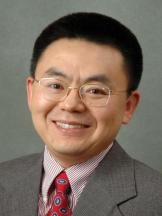Scientists cooking up alloy “recipes” for bone implants
18 Jan 2014
Armed with microscopes, computers and an innovative way to study metals, researchers at The Ohio State University and their partners are building a database of new titanium alloys.
 The goal? To reduce the stress that pins, plates and other medical implants put on healthy bones.
The goal? To reduce the stress that pins, plates and other medical implants put on healthy bones.
Project leader Ji-Cheng (J.-C.) Zhao said that the $1 million grant his team has received from the National Science Foundation's Designing Materials to Revolutionize and Engineer our Future (DMREF) initiative will fund three years of research efforts and support graduate students on the project. Ohio State undergraduates will be involved as well.
The NSF initiative is part of a broader national Materials Genome Initiative announced by President Obama two years ago.
Zhao and Hamish Fraser, Ohio Eminent Scholar and professor of materials science and engineering at Ohio State, are collaborating with researchers at Penn State to build the database. It will provide a reference guide to properties of alloys on the molecular scale. Other researchers will be able follow the guide like a cookbook to formulate titanium alloys for different applications - most notably, medical implants.
''We need to know how much an alloy's properties vary with composition,'' said Zhao, also a professor of materials science and engineering. ''If we add a certain amount of molybdenum, and more or less niobium or tantalum to the titanium, what will happen? Will the alloy be stable? Will it be strong? We need to get that recipe.''
Plain titanium isn't an ideal implant material, he explained.
Bones naturally flex to absorb some of the impact of our movements. Titanium is less flexible, so wherever it connects to bone in the body, the titanium side of the connection flexes less than the bone. This stress and strain weakens the bone over time, and can break the connection to the implant-or break the bone itself.
Yet, titanium is strong, non-toxic and easy to work with. So researchers would like to figure out how to increase its flexibility while retaining its more desirable qualities.
Zhao and his colleagues believe that adding bits of other chemical elements to titanium could create alloys that more closely match with bone. But which elements to add, and how much to add, are open questions.
And while humans have been creating alloys for millennia, the process is traditionally slow and labor-intensive. Computer simulations help speed things up, and that's the role that Penn State will play.
Meanwhile, Zhao will employ a time-saving technique he invented more than a decade ago while working at General Electric. He places small pieces of metal close together and heats them to high temperatures, so that atoms on the edges quickly diffuse to form just a sliver of alloy with a range of compositions between the metals.
The sliver's structure can be quite complex, depending on how many materials combine to form it and how wide a composition range it covers. Fraser will use his expertise in microscopy to study the alloys' structures on a molecular level, using tools at the university's new Center for Electron Microscopy and Analysis. Zhao will use ultrafast laser-based methods to probe the alloys' properties.
DMREF is part of the Materials Genome Initiative for Global Competitiveness, which aims to reduce material development time by ''providing the infrastructure and training that American innovators need to discover, develop, manufacture and deploy advanced materials in a more expeditious and economical way'' and to ensure that the United States remains at the forefront of the world's advanced materials marketplace.






























